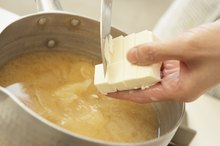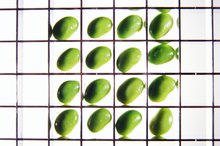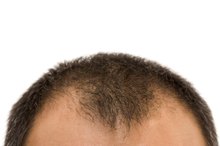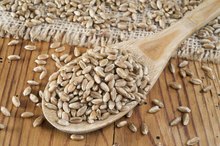What does fact checked mean?
At Healthfully, we strive to deliver objective content that is accurate and up-to-date. Our team periodically reviews articles in order to ensure content quality. The sources cited below consist of evidence from peer-reviewed journals, prominent medical organizations, academic associations, and government data.
The information contained on this site is for informational purposes only, and should not be used as a substitute for the advice of a professional health care provider. Please check with the appropriate physician regarding health questions and concerns. Although we strive to deliver accurate and up-to-date information, no guarantee to that effect is made.
Foods That Act Like Estrogen
Both naturally occurring food components as well as certain additives have the ability to act like estrogen once inside your body. Phytoestrogens include isoflavones and lignans, both found naturally in foods. These phytoestrogens may help combat the effects of menopause and increase bone mass, although their effects on health are still under investigation and not well understood. On the other hand, xenoestrogens are food additives that may be causing more harm to your body than good.
Soy
Soy is an isoflavone and a phytoestrogen. Soy isoflavones can also bind to estrogen receptors, causing a weak estrogen-like effect inside the body. According the Linus Pauling Institute, soy isoflavones may benefit the health of your skeletal system; increasing your intake of soy stimulates bone growth due to its phytoestrogen properties 12. Lower estrogen after menopause can cause of a decrease in bone mass, and a diet high in soy can mimic estrogen and cause the body to maintain its bone integrity.
- Soy is an isoflavone and a phytoestrogen.
- According the Linus Pauling Institute, soy isoflavones may benefit the health of your skeletal system; increasing your intake of soy stimulates bone growth due to its phytoestrogen properties 1.
Seeds
Soy Estrogen and Weight Gain
Learn More
Lignans -- or seeds such as flaxseed, pumpkin seed, poppy, sesame and whole grains -- are naturally occurring foods that act like estrogen. Lignans are known as phytoestrogens 3. These foods are able to bind to estrogen receptors and mimic the action of the hormone produced by the body. However, the Linus Pauling Institute clarifies that these lignans are not nearly as powerful as estrogen, the hormone produced by the body 12. There is little evidence linking lignans to any harmful health effects.
Other Sources of Phytoestrogens
Other foods provide phytoestrogens. Legumes, including chickpeas and lentils boost your phytoestrogen intake, and whole grains -- including millet and sorghum -- also contain phytoestrogens. You'll also find phytoestrogens in the produce aisle -- berries, broccoli, brussels sprouts and kale are especially rich in these chemicals. Some herbs, such as thyme, also offer estrogen-like compounds.
- Other foods provide phytoestrogens.
- Legumes, including chickpeas and lentils boost your phytoestrogen intake, and whole grains -- including millet and sorghum -- also contain phytoestrogens.
Additives
Foods That Reduce the Production of the Androgen Hormones
Learn More
Xenoestrogens are food additives that mimic the work of the hormone estrogen inside the body. According to a study published by "Chemical Research in Toxicology" in 2009, these xenoestrogens can cause negative health effects such as in increase in breast cancer for women and a reduction in sperm for men. During the study, researchers found a new way to identify xenoestrogens inside food. The researchers also discovered two previously unidentified xenoestrogens. Propyl gallate is a preservative used to prevent spoiling in fatty foods; the other, 4-hexylresorcinol, is an additive used to prevent discoloration in shellfish.
- Xenoestrogens are food additives that mimic the work of the hormone estrogen inside the body.
- During the study, researchers found a new way to identify xenoestrogens inside food.
Related Articles
References
- Linus Pauling Institute: Lignans
- Linus Pauling Institute: Soy Isoflavones
- NYU Langone Medical Center: Phytoestrogens
- Science Daily.com: Two Food Additives Have Previously UnRecognized Estrogen-like Effects; March 2009
- Oregon State University: Phytochemicals
- Zhang GQ, Chen JL, Liu Q, et al. Soy Intake Is Associated With Lower Endometrial Cancer Risk: A Systematic Review and Meta-Analysis of Observational Studies. Medicine (Baltimore). 2015 Dec;94(50):e2281. doi:10.1097/MD.0000000000002281.
- Tse G, Eslick D. Soy and isoflavone consumption and risk of gastrointestinal cancer: a systematic review and meta-analysis. Eur J Nutr. 2016 Feb;55(1):63-73. doi: 10.1007/s00394-014-0824-7
- Anderson JW, Bush HM. Soy protein effects on serum lipoproteins: a quality assessment and meta-analysis of randomized, controlled studies. Journal of the American College of Nutrition 2011 Apr;30(2):79-91.
- Greendale GA, Tseng CH, Han W, et al. Dietary Isoflavones and Bone Mineral Density during Mid-Life and the Menopause Transition: Cross-Sectional and Longitudinal Results from the SWAN Phytoestrogen Study. Menopause. 2015 Mar;22(3):279-88. doi:10.1097/GME.0000000000000305
- Rietjens IMCM, Louisse J, Beekmann K. The potential health effects of dietary phytoestrogens. Bri J Pharmacol. 2017 Jun;174(11):1263-80. doi:10.1111/bph.13622
- Terzic M, Micic J, Dotlic J, et al. Impact of Phytoestrogens on Serum Lipids in Postmenopausal Women. Geburtshilfe Frauenheilkd. 2012 Jun;72(6):527-31. doi:10.1055/s-0031-1298624
- Wei P, Liu M, Chen Y, Chen DC. Systematic review of soy isoflavone supplements on osteoporosis in women. Asian Pac J Trop Med. 2012 Mar;5(3):243-8. doi:10.1016/S1995-7645(12)60033-9
- Yu Y, Jing X, Li H, et al. Soy isoflavone consumption and colorectal cancer risk: a systematic review and meta-analysis. Sci Rep. 2016;6:25939. doi:10.1038/srep25939
- Ziaei S, Halaby R. Dietary Isoflavones and Breast Cancer Risk. Medicines (Basel). 2017 Jun;4(2):18. doi:10.3390/medicines4020018
Writer Bio
Laura Niedziocha began her writing career in 2007. She has contributed material to the Stoneking Physical Therapy and Wellness Center in Lambertville, N.J., and her work has appeared in various online publications. Niedziocha graduated from Temple University with a Bachelor of Science in exercise science. She also has her Associate of Arts in communications from the Community College of Philadelphia.









